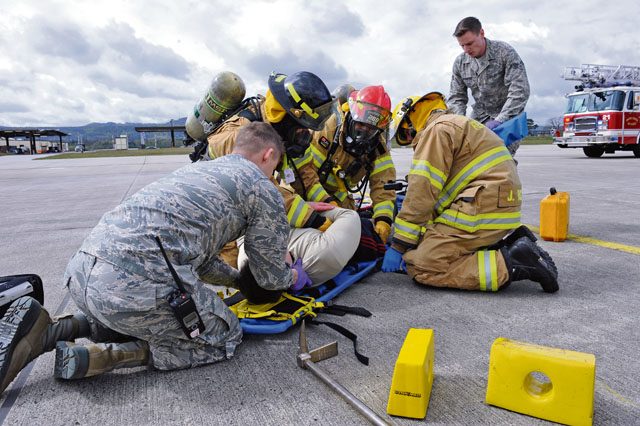
Team Ramstein participated in a base-wide inspection from April 17 to 27.
Wing Thunder 16-03 tested operational readiness and communication skills amongst several units on Kaiserslautern Military Community installations.
There was a simulated missile attack scenario, April 26, which involved several first responders, such as the fire department, security forces, explosive ordnance disposal team and medical personnel.
“This exercise tested preparation and response actions we haven’t used in a long time,” said Brig. Gen. Jon T. Thomas, 86th Airlift Wing commander. “We intentionally developed a unique situation to better test the adaptability and responsiveness of our Airmen.”
Inspections and exercises are a way for military units and personnel to ensure they are prepared for any real-world scenario.
“The overall goal of Wing Thunder 16-03 was to increase installation preparedness and resiliency in case of a conventional missile attack,” said Lt. Col. Bryan Dockter, 86th AW inspector general. “All of the installation’s major muscle movements associated with passive missile defense and post-attack actions were exercised.”
These exercises help to point out areas needing additional training and processes that may not be as effective as required in a real-world situation.
“We continuously strive to become better at our processes and to improve our training,” Thomas said. “Team Ramstein continues to prepare themselves with the knowledge and equipment to address any situation and have the ability to respond rapidly to meet any challenge we’re given.”
The 10-day inspection included functions such as loading cargo on and deploying multiple C-130J Super Hercules aircraft, prepping Airmen with individual protective equipment, setting up a predeployment line to process personnel and several other base-wide entities.
“One of the best outcomes in any exercise is to watch the men and women of the installation work together, be it from first responders, to Post Attack Reconnaissance (PAR) teams conducting facility and personnel checks, to the Crisis Action Team and Emergency Operations Center working in cohesion to bring the exercise to a successful conclusion,” Dockter said. “You can bet that the installation will exercise this scenario again with an eye to execute even better than we did this time.”


